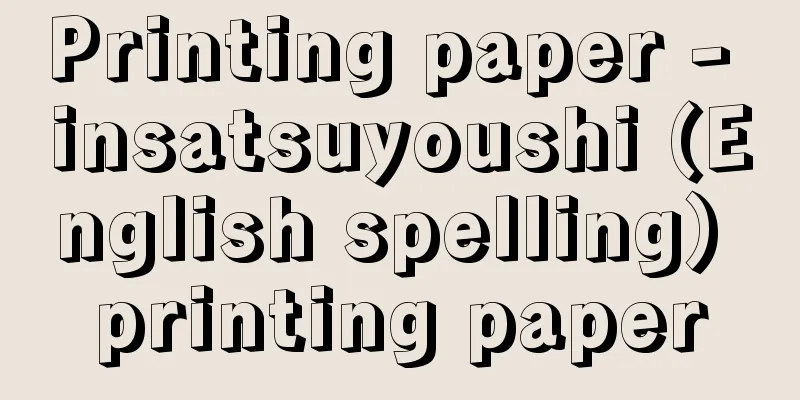Printing paper - insatsuyoushi (English spelling) printing paper

|
Paper manufactured for printing. The primary purpose of paper's invention was to store and transmit information, and printing on paper remains an effective means of storing and transmitting information today. [Akio Mita April 18, 2016] Raw materials for printing paperTraditionally, bleached wood pulp was used as the main raw material, or groundwood pulp was added to it. However, from around 1970, awareness of global environmental issues began to grow, and technological developments to address these issues progressed. The recovery rate of waste paper increased to reduce paper waste, and technologies such as dust removal, screening, deinking, and bleaching improved, improving the quality of recycled pulp and allowing it to be used as a raw material for printing paper. In the past, recycled pulp from waste paper was of low quality and could only be used for paperboard, but in 2014, of the 17.09 million tons of waste paper consumed annually, 2 million tons were used for magazines and 4.07 million tons were used as a raw material for newsprint, and recycled pulp began to be used in large quantities for newsprint and low-grade printing paper. Printing paper is made primarily from various types of pulp, with secondary ingredients such as fillers to increase the opacity of the paper and sizing agents to prevent ink bleeding, and is usually made on a Fourdrinier papermaking machine. Paper made on a twin-wire papermaking machine has little difference between the front and back, is smooth, and is suitable for high-speed printing and mass production, so it is used to make low-grade printing paper. Depending on the use of the made paper, it is often given a super finish to give it a glossy finish by passing it through a calendar (a machine that passes the paper between several rotating iron rolls to smooth out any unevenness on the paper's surface) or a surface coating. [Akio Mita April 18, 2016] Printing paper typePrinting paper includes high-grade, medium-grade, and low-grade printing paper, gravure paper, thin paper, and coated printing paper. (1) Premium printing paper: Paper made from 100% chemical pulp, including printing paper A and others. Printing paper A is made from 100% bleached chemical pulp and is a representative type of printing paper used for books, textbooks, commercial printing, etc. (2) Medium-grade printing paper: Paper that contains more chemical pulp than low-grade printing paper. Printing paper B has a chemical pulp content of 70% or more and is used for the main text of textbooks and books. Printing paper C has a chemical pulp content of 40-70% and a whiteness of around 65%, and is used for the main text of magazines and telephone directories. (3) Gravure paper: Contains mechanical pulp. To make it suitable for gravure printing, it is super calendared to give it a smooth surface. (4) Low-grade printing paper Printing paper D has a chemical pulp content of less than 40% and a whiteness of around 55%, and is used as the body paper for magazines. Printing Senka paper is a bulky special coarse paper made from 100% recycled pulp from waste paper, and is used as the body paper for comic books. (5) Tissue Printing Paper Tissue printing paper can be divided into India paper, typing paper, copy paper, and other thin printing papers. India paper, which is representative of tissue paper, is a high-quality paper that is strong yet soft, highly opaque, and extremely thin (0.04 to 0.05 mm thick), and is used for Bibles, dictionaries, and the Six Codes. In the past, the main raw pulp materials used for the paper were expensive and extremely strong hemp pulp and cotton pulp, and cheap and soft sulfite pulp from conifers was mixed in with the pulp. Later, when cheap and strong bleached kraft pulp from hardwoods appeared on the market, the proportion of bleached kraft pulp gradually increased, and today India paper is made from 100% bleached kraft pulp, and many dictionaries and other documents are printed on this strong but crisp paper. (6) Coated printing paper Paper that has been coated. Of these, art paper has about 40 grams of paint applied to each side per square meter, and is used for fine art printing and calendar paper. Fine coated paper has about 20 grams of paint applied to each side per square meter on fine paper, and is used for high-end art books, magazine covers, posters, etc. Lightly coated printing paper has less than 12 grams of paint applied to each side per square meter on medium quality paper, and since it uses medium quality paper that contains mechanical pulp as a raw material, it is thin but has high opacity and can withstand double-sided color printing, so it is often used for newspaper inserts. Japan's paper production volume excluding paperboard was 15.12 million tons in 2014. Of this, approximately 77%, or 11.63 million tons, was printing and information paper and newsprint, indicating that most of the paper is used for transmitting and storing information. [Akio Mita April 18, 2016] "Paper and Pulp Technology Handbook" (1992), compiled and published by the Paper and Pulp Association ; "How to Use Printing Paper Well" by Nomura Tadayoshi (1993, Japan Printing Newspaper) ; "How to Use Printing Paper" by Hara Hiroshi (1997, Printing Society of Japan Publishing Division); "Current State of the Paper and Pulp Industry" compiled and published by the Japan Paper Association (Monthly Paper and Pulp Special Issue 2001, 2001); "Printing and Paper 2005" (2005), compiled by Paper Times Co., Ltd. [Reference items] | | | | | | | | |Recycled | | | | |Source: Shogakukan Encyclopedia Nipponica About Encyclopedia Nipponica Information | Legend |
|
印刷用に製造された紙。紙の発明の最大の目的が情報の保存および伝達であったが、紙への印刷は今日でも情報の保存と伝達の有効な手段である。 [御田昭雄 2016年4月18日] 印刷用紙の原料従来、木材の晒(さらし)パルプを主原料とするか、またはこれに砕木パルプを加えて主原料としていた。しかし、1970年(昭和45)ごろから地球環境問題が意識されるようになり、その対策のための技術開発が進み、紙くず減らしのために古紙の回収率があがり、除塵(じょじん)、精選、脱墨、漂白などの技術が進歩したため、再生パルプの品質が向上し、印刷用紙原料として使われるようになった。かつては古紙の再生パルプは低品質で板紙にしか使えなかったが、2014年(平成26)には年間消費される古紙1709万トンのうちの200万トンが雑誌などに、407万トンが新聞用紙の原料として利用され、再生パルプは新聞用紙や下級印刷用紙などに大量に使われるようになった。 印刷用紙は各種パルプを主原料とし、副原料として紙の不透明度を増すために填料(てんりょう)、インキのにじみ止めとしてサイズ剤などを配合し、通常長網抄紙機(ながあみしょうしき)を用いて抄紙する。またツインワイヤー抄紙機で製造する紙は、表裏差が少なく、平滑で、高速印刷の適性があり大量生産に向くので、下級印刷用紙の製造に使われている。抄紙された紙の用途によっては、カレンダー(数本の鉄製の回転ロールの間に紙を通すことにより、紙の表面の凹凸をつぶし、平滑処理を行う機械)を通して光沢を付けるスーパー仕上げをしたり、表面塗工したりすることが多い。 [御田昭雄 2016年4月18日] 印刷用紙の種類印刷用紙には、上級印刷用紙から中級、下級印刷用紙、グラビア用紙、薄葉紙(うすようし)、塗工印刷用紙などがある。 (1)上級印刷用紙 化学パルプ100%で抄造した紙で、印刷用紙Aその他がある。印刷用紙Aは晒化学パルプを100%使用したもので、書籍用紙など印刷用紙の代表品種で、教科書、商業印刷などに使われる。 (2)中級印刷用紙 化学パルプを下級印刷用紙より多く配合した紙で、印刷用紙Bは配合率70%以上で教科書、書籍の本文用紙などとして使われる。印刷用紙Cは化学パルプの配合率が40~70%で白色度65%前後、雑誌の本文用紙、電話帳の本文用紙などに使われる。 (3)グラビア用紙 機械パルプを含有する。グラビア印刷の適性を出すため、スーパーカレンダー仕上げをして表面を平滑にする。 (4)下級印刷用紙 印刷用紙Dは化学パルプの配合率が40%未満で白色度55%前後、雑誌の本文用紙として使用される。印刷仙花紙は古紙の再生パルプ100%のかさ高の特殊更紙(ざらがみ)で、漫画本の本文用紙として使われる。 (5)薄葉印刷紙 インディアペーパー(インディア紙)、タイプ用紙、コピー用紙、その他薄葉印刷用紙に分けられる。薄葉紙を代表するインディアペーパーは、本来強度がありながら柔らかく、そして不透明度が高くきわめて薄くて(厚さ0.04~0.05ミリメートル)高級感のある紙で、聖書や辞書や六法全書などに用いられる。かつては、その原料パルプとして、高価で強度がきわめて大きい麻パルプ、綿パルプ等を主原料とし、安価で柔らかい針葉樹の亜硫酸パルプを配合して抄造していた。のちに、安くてじょうぶな広葉樹の晒クラフトパルプが市場に現れてからは順次その配合割合が増え、現在では、晒クラフトパルプ100%のインディアペーパーが抄造され、強度はあるが、ぱりぱりした感じの紙に辞書などの多くが印刷されるようになった。 (6)塗工印刷用紙 紙に塗工処理を行ったもの。そのうちアート紙は1平方メートル当り両面で40グラム前後の塗料を塗布したもので、美術印刷用紙やカレンダー用紙として使われる。上質コート紙は上質紙に塗料を1平方メートル当り両面で20グラム前後塗布したもので、高級美術書、雑誌の表紙、ポスターなどに使用される。微塗工印刷紙は中質紙に塗料を1平方メートル当り両面で12グラム以下塗布したもので、原料として機械パルプを配合した中質紙を使っているため、薄くとも不透明度が高く、両面カラー印刷に耐えるので新聞の折込広告などに好んで使われる。 日本における2014年の板紙を除いた紙の生産量は1512万トンである。そのうち約77%にあたる1163万トンは印刷・情報用紙および新聞用紙であり、これは紙のほとんどが情報の伝達と保存に使われていることを示している。 [御田昭雄 2016年4月18日] 『紙パルプ連合会編・刊『紙パルプ技術便覧』(1992)』▽『野村忠義著『上手に付き合う印刷用紙』(1993・日本印刷新聞社)』▽『原啓志著『印刷用紙とのつきあい方』(1997・印刷学会出版部)』▽『日本製紙連合会編・刊『紙・パルプ産業の現状』(月刊『紙・パルプ』2001年特集号・2001)』▽『紙業タイムス社編『印刷と用紙 2005』(2005)』 [参照項目] | | | | | | | | | | | | | |出典 小学館 日本大百科全書(ニッポニカ)日本大百科全書(ニッポニカ)について 情報 | 凡例 |
Recommend
Green Mountain
…The state capital is Montpelier, and the largest...
charrada
… [Folk dance, regional dance | bailes regionales...
FIM (Microscope)
…It is also called a field ion microscope, abbrev...
Iruma Prefecture
The following year, the area was divided into Sai...
Corrected vision - corrected vision
〘 noun 〙 Vision corrected by glasses or contact le...
Semi-killed steel
…Continuous casting has been used for non-ferrous...
solifluction lobe
...The formation of the stone pavement, which is ...
Zinsser, R. (English spelling) ZinsserR
...Large-scale epidemics such as the plague and c...
British Association for the Advancement of Science
The purpose of this association was to have scien...
Urashimasou - Urashimasou
A perennial plant of the Araceae family (APG clas...
Shuzo Takiguchi
Poet and art critic. Born in Toyama Prefecture. St...
Mantova (English spelling)
The capital of the province of Mantua in Lombardy...
Tatewakumon
A pattern of wavy lines facing each other vertical...
Letter of loyalty - Gunchujo
A document in which a medieval warrior wrote down...
Cremona (English spelling)
The capital of the province of Cremona in Lombardy...









